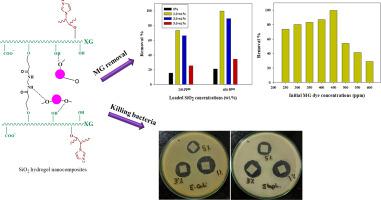International Journal of Biological Macromolecules ( IF 8.2 ) Pub Date : 2021-09-16 , DOI: 10.1016/j.ijbiomac.2021.09.040 Mahmoud H Abu Elella 1 , Emad S Goda 2 , Heba Gamal 3 , Salah M El-Bahy 4 , Mohamed A Nour 5 , Kuk Ro Yoon 6

|
Recently, removal of synthetic dyes, especially cationic dye of malachite green (MG), and inhibition of the growth of pathogenic microorganism from drinking water have gained much interest due to their high toxic potency for aquatic biosystems. Herein, a new dye adsorbent with outstanding antibacterial activity was fabricated based on xanthan gum (XG) and SiO2 nanoparticles through ultrasonication followed by the crosslinking polymerization with vinyl imidazole monomer. The nano adsorbents were characterized with various techniques such as FTIR, XRD, SEM, EDX, and TEM. The nanocomposites were applied as a filter for discarding MG dye and killing the growth of bacterial strains such as E.coli and S.aureus which are considered as the common impurities for drinking water. The data revealed that a maximum adsorption capacity was recorded as 99.5% (Qmax = 588.2 mg/g) at optimum conditions including 10 mg nanocomposite, 10 mL of MG dye (450 ppm), pH = 7, the temperature of 30 °C, and the adsorption time was adjusted within 6 h. The process of dye adsorption was applied to the common isotherm models of Langmuir, Temkin, and Freundlich, and the findings showed that the adsorption behavior was well fitted with the Langmuir one (R2 = 0.9983). Moreover, different adsorption kinetic models such as pseudo-first order, pseudo-second order, and intra-particle diffusion were studied for understanding the mechanism of MG adsorption onto nanocomposite surface. It was found that both intraparticle diffusion and pseudo-first-order have participated evenly in the adsorption mechanism of MG dye. Ultimately, the as-prepared nanocomposites were tested against the growth of S. aureus, and E.coli manifesting a superior inhibition diameter as 23.5 ± 0.50, and 25.33 ± 0.47 mm against E.coli, and S. aureus, respectively. Therefore, our new XG-g-PVI/SiO2 adsorbent is a very promising adsorbent for the fast and efficient capture of dyes from aqueous solutions.
中文翻译:

用于孔雀石绿染料的含有接枝黄原胶/SiO2纳米复合材料的绿色抗菌吸附剂
近年来,去除合成染料,尤其是孔雀石绿 (MG) 阳离子染料,以及抑制饮用水中病原微生物的生长,因其对水生生物系统的高毒力而受到广泛关注。在此,基于黄原胶(XG)和SiO 2制备了一种具有优异抗菌活性的新型染料吸附剂。通过超声处理制备纳米颗粒,然后与乙烯基咪唑单体交联聚合。纳米吸附剂的表征采用各种技术,如 FTIR、XRD、SEM、EDX 和 TEM。纳米复合材料用作过滤器,用于丢弃 MG 染料并杀死被认为是饮用水常见杂质的大肠杆菌和金黄色葡萄球菌等细菌菌株的生长。数据显示最大吸附容量记录为 99.5% (Q max = 588.2 mg/g) 在最佳条件下,包括 10 mg 纳米复合材料、10 mL MG 染料 (450 ppm)、pH = 7、温度 30 °C,吸附时间调整在 6 h 内。将染料吸附过程应用于Langmuir、Temkin和Freundlich的常见等温线模型,结果表明吸附行为与Langmuir模型非常吻合(R 2 = 0.9983)。此外,研究了不同的吸附动力学模型,如准一级、准二级和颗粒内扩散,以了解 MG 吸附到纳米复合材料表面的机制。发现粒子内扩散和准一级均均匀地参与了MG染料的吸附机制。最终,对制备的纳米复合材料进行了测试,以防止其生长金黄色葡萄球菌和大肠杆菌对大肠杆菌和金黄色葡萄球菌的抑制直径分别为 23.5 ± 0.50 和 25.33 ± 0.47 mm 。因此,我们的新型 XG-g-PVI/SiO 2吸附剂是一种非常有前途的吸附剂,可快速有效地从水溶液中捕获染料。



























 京公网安备 11010802027423号
京公网安备 11010802027423号